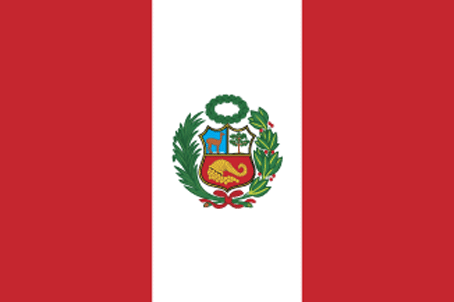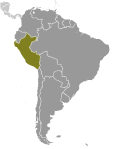
|
|
Advertisements:
People And SocietyNationality
Noun Peruvian(s)
Adjective Peruvian Ethnic groups
Amerindian 45%, mestizo (mixed Amerindian and white) 37%, white 15%, black, Japanese, Chinese, and other 3% Languages
Spanish (official) 84.1%, Quechua (official) 13%, Aymara (official) 1.7%, Ashaninka 0.3%, other native languages (includes a large number of minor Amazonian languages) 0.7%, other 0.2% (2007 Census) Religions
Roman Catholic 81.3%, Evangelical 12.5%, other 3.3%, unspecified or none 2.9% (2007 Census) Population World Ranking: 42
29,549,517 (July 2012 est.)
Age structure
0-14 years
28.5% (male 4,245,023/female 4,101,220) 15-64 years 65.1% (male 9,316,128/female 9,722,258) 65 years and over 6.4% (male 885,703/female 978,611) (2011 est.) Median age
Total 26.5 years
Male 25.8 years Female 27.2 years (2012 est.) Population growth rate World Ranking: 117
1.016% (2012 est.)
Birth rate World Ranking: 96
19.13 births/1,000 population (2012 est.) Death rate World Ranking: 164
5.95 deaths/1,000 population (July 2012 est.) Net migration rate World Ranking: 175
-3.03 migrant(s)/1,000 population (2012 est.) Urbanization
Urban population 77% of total population (2010)
Rate of urbanization 1.6% annual rate of change (2010-15 est.) Major cities - population
LIMA (capital) 8.769 million; Arequipa 778,000 (2009) Sex ratio
At birth 1.05 male(s)/female
Under 15 years 1.03 male(s)/female 15-64 years 0.96 male(s)/female 65 years and over 0.9 male(s)/female Total population 0.97 male(s)/female (2011 est.) Maternal mortality rate World Ranking: 91
67 deaths/100,000 live births (2010) Infant mortality rate World Ranking: 90
Total 21.5 deaths/1,000 live births
Male 23.78 deaths/1,000 live births Female 19.12 deaths/1,000 live births (2012 est.) Life expectancy at birth World Ranking: 126
Total population 72.73 years
Male 70.78 years Female 74.76 years (2012 est.) Total fertility rate World Ranking: 96
2.29 children born/woman (2012 est.) Health expenditures World Ranking: 147
4.6% of GDP (2009)
Physicians density
0.92 physicians/1,000 population (2009) Hospital bed density
1.5 beds/1,000 population (2009) Hiv/aids - adult prevalence rate World Ranking: 70
0.4% (2009 est.)
Hiv/aids - people living with hiv/aids World Ranking: 48
75,000 (2009 est.)
Hiv/aids - deaths World Ranking: 38
5,000 (2009 est.)
Major infectious diseases
Degree of risk Very high
Food or waterborne diseases Bacterial, hepatitis A, and typhoid fever Vectorborne disease Dengue fever, malaria, and yellow fever Water contact disease Leptospirosis (2009)Obesity - adult prevalence rate World Ranking: 29
16.3% (2000)
Children under the age of 5 years underweight World Ranking: 81
5.4% (2005)
Education expenditures World Ranking: 141
2.7% of GDP (2008)
Literacy
Definition
Age 15 and over can read and write Total population 92.9%Male 96.4% Female 89.4% (2007 Census) School life expectancy (primary to tertiary education)
Total 14 years
Male 13 years Female 13 years (2006) Unemployment, youth ages 15-24 World Ranking: 82
Total 14%
Male 12.5% Female 15.6% (2008)
Comments
Add a new comment: |
Advertisement
Members area
Peru (Lima):
 
GPS points from Peru (Lima)
|
||||||||

 Ancient Peru was the seat of several prominent Andean civilizations, most notably that of the Incas whose empire was captured by the Spanish conquistadors in 1533. Peruvian independence was declared in 1821, and remaining Spanish forces were defeated in 1824. After a dozen years of military rule, Peru returned to democratic leadership in 1980, but experienced economic problems and the growth of a violent insurgency. President Alberto FUJIMORI's election in 1990 ushered in a decade that saw a dramatic turnaround in the economy and significant progress in curtailing guerrilla activity. Nevertheless, the president's increasing reliance on authoritarian measures and an economic slump in the late 1990s generated mounting dissatisfaction with his regime, which led to his ouster in 2000. A caretaker government oversaw new elections in the spring of 2001, which ushered in Alejandro TOLEDO Manrique as the new head of government - Peru's first democratically elected president of Native American ethnicity. The presidential election of 2006 saw the return of Alan GARCIA Perez who, after a disappointing presidential term from 1985 to 1990, has overseen a robust macroeconomic performance. In June 2011, former army officer Ollanta HUMALA Tasso was elected president, defeating Keiko FUJIMORI Higuchi, the daughter of Alberto FUJIMORI. Since his election, HUMALA has carried on the sound, market-oriented economic policies of the three preceeding administrations.
Ancient Peru was the seat of several prominent Andean civilizations, most notably that of the Incas whose empire was captured by the Spanish conquistadors in 1533. Peruvian independence was declared in 1821, and remaining Spanish forces were defeated in 1824. After a dozen years of military rule, Peru returned to democratic leadership in 1980, but experienced economic problems and the growth of a violent insurgency. President Alberto FUJIMORI's election in 1990 ushered in a decade that saw a dramatic turnaround in the economy and significant progress in curtailing guerrilla activity. Nevertheless, the president's increasing reliance on authoritarian measures and an economic slump in the late 1990s generated mounting dissatisfaction with his regime, which led to his ouster in 2000. A caretaker government oversaw new elections in the spring of 2001, which ushered in Alejandro TOLEDO Manrique as the new head of government - Peru's first democratically elected president of Native American ethnicity. The presidential election of 2006 saw the return of Alan GARCIA Perez who, after a disappointing presidential term from 1985 to 1990, has overseen a robust macroeconomic performance. In June 2011, former army officer Ollanta HUMALA Tasso was elected president, defeating Keiko FUJIMORI Higuchi, the daughter of Alberto FUJIMORI. Since his election, HUMALA has carried on the sound, market-oriented economic policies of the three preceeding administrations.